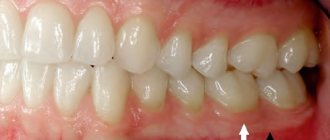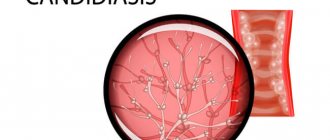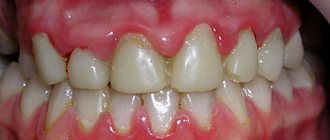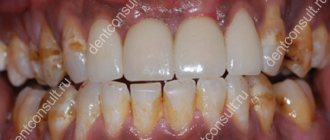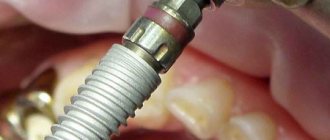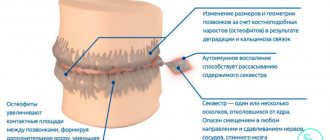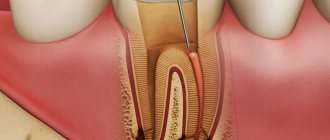Where does the treatment of dental recession begin?
Treatment of recession must begin, first of all, by eliminating the cause - what caused it, what caused the gum recession.
After this, depending on the Miller class, surgical treatment is performed - closing the exposed area. Since gum recession occurs in conditions of a broken bite, it is logical to begin treatment in order to stop the process of recession itself. And here we should note the professionalism of our orthodontists.
We, at the German Implantology Center, effectively follow the approach: first we correct the bite and stop the recession, and only then we treat the recession itself and restore the gum level. To immediately restore gums without eliminating the cause is a symptomatic treatment, extremely ineffective and, in fact, useless.
Our clinics value the time of our patients and offer only proven treatment methods that meet the principles of reliability and effectiveness in the long term.
Causes
Gum recession can occur for a number of reasons:
- lack of high-quality oral hygiene (based on the epidemiology of the formation of pathology, the dependence of its indicators on hygienic cleaning has been revealed);
- long-term accumulation of soft and hard deposits, leading to the occurrence of an inflammatory process;
- diseases of the gum tissue - periodontal disease, periodontitis and gingivitis;
- mechanical damage to thinned gums - long-term rough cleaning, use of a very hard brush;
- bad habits;
- shortened lip frenulum;
- malocclusion;
- violations when performing implantation surgery or choosing prosthetic structures.
Partially, the etiology of the development of the pathology is associated with the older age of the patients; in people over 45 years of age, this pathology occurs quite often. Also, the reason for the decrease in the volume of gingival and bone tissue is the removal of the unit and the failure to timely restore the gap with a prosthesis.
About orthodontic treatment to stop gum recession
These can be orthodontic structures: braces, or aligners, or something else - this is what the orthodontist will choose, it is he who determines which technique for correcting the bite in a given case of recession will be best applicable for each specific patient. There are no universal treatments. The only question that is subject to discussion is how long orthodontic treatment will take in one way or another.
As a result of treatment, the orthodontist must place the teeth in a physiological occlusion so that the tooth/teeth do not bear such a load that they experience excessive chewing stress at the time of contacting the doctor.
And then, when the tooth is placed in the functionally correct position, the following happens to the gum. Gum recession stops. And again, if it stops at such a level that closing the recession is possible, then the gums subsequently rise and the recessions close.
And after some intervention, perhaps the gums will return in full.
Cases where orthodontic treatment eliminates recession
We cannot always close all gum recessions with the help of orthodontics. We remove the cause of the recession, that is:
- malocclusion,
- we correct occlusal contacts that lead to this recession,
- eliminating improper stress on teeth,
- We eliminate the lack of load in the case of an extracted tooth and the overload, in turn, of neighboring teeth.
And after the doctor has normalized the patient’s bite and normalized the correct closure of his teeth, we refer him to a periodontist who will perform gum plastic surgery.
In any case, the pathological process of gum loss stops after our treatment; it no longer progresses. And we always wait after removing braces (or other orthopedic structures) from 3 to 6 months
for the gums to recover and calm down. And after this, if necessary, plastic surgery of the frenulum, plastic surgery of the vestibule of the oral cavity is performed - all this is done only after orthodontic treatment.
Why is plastic surgery done AFTER, and not BEFORE, bite correction?
Because a scar is formed inside the operated tissue, which in the future can interfere with the movement of teeth when correcting the bite.
Potential Complications
Recession of gingival tissue is an independent disease that requires competent therapy. If left untreated, it can lead to much more serious consequences than a violation of the aesthetics of a smile.
First, food gets clogged into the gaps between the teeth, causing bad breath. Next, inflammation develops, which can be accompanied by severe pain, discharge of pus and loosening of the teeth.
Increased sensitivity and soreness develop in the area of the gum margin, which makes eating difficult.
Teeth and roots are affected by caries. In advanced cases, lack of treatment can lead to the loss of one or several dental units at once.
The easiest way to notice when the gums on the front teeth recede, what to do in this case is well known - sign up for a consultation with dentistry to choose a treatment method.
Surgery to close gum recession
The gum itself, as you understand, will not rise, it will not “bounce into place”, it needs to be put back in its original place, and this is called closing the gum recession.
But I repeat once again: there are also indications and contraindications for the operation, in accordance with certain classes of gum recession according to Miller.
If this is a class one recession, then one forecast. If this is class II gum recession, the prognosis is different. There are many contributing factors to both successful gum recession and failure. That is, at the very beginning of the treatment path, the doctor must determine all the factors for successful closure of gum recession.
Stages of gum tissue recession
Treatment of the pathology is prescribed based on its stage and form. The following symptoms will help identify them (according to the Miller classification accepted in dentistry):
- tissue loss is hardly noticeable and is visible only at the junction of the dental crown to the gum - the initial stage of subsidence, easily treatable;
- at the point of contact between the gum tissue and the neck of the tooth, the gum level is below normal by 1-2 mm, while the defect does not appear between the teeth;
- receding gums by 3 mm or more, at this stage the necks of the teeth are exposed, soft tissues may bleed, the bone level remains at the same level;
- receding gums by 5 mm or more, accompanied by exposure of tooth roots and mobility of dental units, the most severe stage.
At advanced stages, the gums on the front teeth most often recede - the defect is clearly visible without additional diagnostics.
At the beginning of the disease, it can be determined by the following symptoms:
- the presence of inflammation and bleeding;
- swelling of the mucous membrane;
- formation of periodontal pockets;
- increased sensitivity of enamel;
- pain when brushing teeth;
- whitish tint of gums.
It is worth adding that the disease can affect both the lower and upper jaws, or both at once. In addition, recession can be localized - within 1-2 dental units, and generalized, when the deformation of the gingival contour spreads to the entire jaw.
Regardless of whether the gums have receded on the lower teeth or on the upper ones, you need to seek help from a specialist.
Miller classification
Today, the generally accepted classification of gum recession is the Miller classification, which is divided into 4 classes
.
First and second classes
according to Miller - root closure is 100 percent possible.
Third class
according to Miller, 100 percent root closure is impossible.
And fourth grade
according to Miller, he is not even being treated.
What treatments are available for each stage of gum recession?
For the first, second and third classes according to Miller - only surgical closure of the exposed necks of the roots of the teeth. The fourth class according to Miller is not treatable, that is, it cannot be treated.
Is there an age limit for treating gum recession?
No.
There is no age limit for treating gum recession.
Consequences
If the recession of the gingival tissue is not eliminated in a timely manner, then in response to the primary untreated symptoms the following will develop:
- putrid odor from the mouth;
- acute pain when eating in the gum area;
- worsening of the carious process on the exposed parts of the root up to the pulp chamber;
- formation of wedge-shaped defects;
- swelling and inflammation of the gum tissue;
- deep periodontal pockets. - appears in the patient.
In addition to external and internal manifestations, pathology has a psycho-emotional impact. The smile loses its attractiveness and the patient develops a psychological barrier in conversation.
Drug treatment of advanced forms of recession will only be used as maintenance therapy in clinics in St. Petersburg and Leningrad. region Treatment will be more expensive because surgical intervention will be required.
Treatment methods – therapeutic and surgical
*Photos before and after recession treatment
Typically, surgical and non-surgical (therapeutic) methods are used. Each of them depends on the severity of the disease. But operations are more popular because they are more effective and reliable.
If we talk about surgical intervention, it is divided into techniques:
- Lateral flap technique. Using special tools, inflammation and deposits on teeth are eliminated. Next, a flap is formed and the tissue is sutured.
- Resorbable membranes. In this situation, a high rigidity membrane is installed. After which it is deleted. But the procedure does not provide a 100% guarantee of complete recovery, so this method is avoided.
- Regeneration. For this purpose, certain components (proteins and enzymes) are used to form renewed healthy gums.
Non-surgical treatment includes collagen therapy. As a rule, it has an effect only at the initial stage of a recession. The damaged area is restored quite quickly, returning a healthy appearance.
general information
The result of gum recession is that the bottom of the tooth is exposed. As a result, not only an aesthetic problem arises, but also the possibility of developing serious pathologies, such as wedge-shaped defects. Increased sensitivity of enamel, caries, etc.
This disease is quite rarely diagnosed at a young age (no more than 10% of patients).
Its manifestation is most often observed in middle and old age. Important! Gum recession belongs to the group of diseases that can have a negative impact on the facial aesthetics and psycho-emotional state of the patient. When you smile, the exposed roots of the teeth are clearly visible, which has an overwhelming effect on self-esteem, causing difficulties in communication and difficulty in social adaptation. And the more pronounced this pathology is, the stronger the person’s psychological uncertainty will be.
Prevention
In order to significantly reduce the risk of developing this disease, experts advise their patients to follow these rules:
- It is necessary to carry out timely treatment of caries, since it is the main cause of the development of recession.
- Visit your dentist regularly for preventative checkups. The earlier this pathology is diagnosed, the less time and effort will be spent on eliminating it.
- Avoid injury and bleeding gums. To do this, it is necessary to correct malocclusions using the most gentle methods possible, periodically strengthening tooth enamel through remineralizing therapy.
- It is necessary to pay significant attention to high-quality oral hygiene. Brush your teeth properly and do not use a brush with too hard bristles.
Gum recession is a serious disease that requires prompt intervention from a specialist. Therefore, it is necessary to periodically undergo a preventive examination at the dentist and practice proper oral hygiene.
Is gum grafting painful?
No . Operations to eliminate gum recession are performed under local anesthesia; the surgical intervention is 100% painless. In the postoperative period, especially with gum plastic surgery using local tissues, patients often do not experience pain at all. If pain occurs, it is usually only on the day of surgery, a couple of hours after the intervention, when the effect of the local anesthetic wears off. During this period, the pain is perfectly eliminated with painkillers prescribed by the doctor. During the entire rehabilitation period, on average, 1-2 painkiller tablets are required.
In cases of gum plastic surgery using a “patch,” unpleasant sensations may be added due to the presence of a donor zone, which, according to patients, resembles the feeling “as if you grabbed hot tea,” but this does not always occur. The presence/absence of pain is determined by the area from which the “patch” is taken. If anatomical conditions allow, doctors can remove the graft from the donor area absolutely painlessly.
In simple words about a complex disease
What is gum recession? This is a pathology of the soft tissues of the oral cavity, which is characterized by a decrease in the mobile (marginal) level of the gum in the apical direction and exposure of the neck and root part of the teeth. Most medical reference books give approximately this definition. In simple terms, the gum literally moves down or up, exposing the tooth. Visually, this resembles low tide, when the water level decreases and the hitherto hidden relief of the coast appears.
Gum recession can occur at any age. However, the disease most often develops in people over fifty years of age. At this age, many patients experience loss of soft tissue edge height, but in most cases this is not very noticeable. The risk of a recession can be predicted. If the fixed and cervical parts of the gum are approximately equal in size, then the likelihood of recession is very high, since ideally the attached part of the gum should be much wider. It is also important to understand that in most cases, recession is a consequence of other diseases and pathological processes. This is why it is important to identify the root cause to create the optimal treatment plan.
